The Marine Hospital
The German-English School Years
The idea of a school for training teachers gave new momentum to an idea that had been floating around Galena for a number of years. The effort began with the German Methodist Episcopal Church in Galena, whose members supported such an effort. They, and the Conference of which they were a part, wanted the school to "teach young ladies and gentlemen to become teachers in German, English, or German-English Schools" (Catalogue of the Northwestern German-English Normal School, 1875, copy in the Marine Hospital folder, Galena State Historic Sites Office).
When a second solicitation for bids came to be, the church's bid of $6,000, double the previous high bid from Felt and Corwith, was accepted (Galena Daily Gazette, 17 October 1868 and 5 November 1868). They wasted no time in lining up teachers and students. Professor Wernli, trained in Switzerland, had first migrated to Milwaukee to teach, but was teaching at the Platteville Normal School when asked to take over the new Galena school; three teachers were initially hired to work under him (Figure 14).
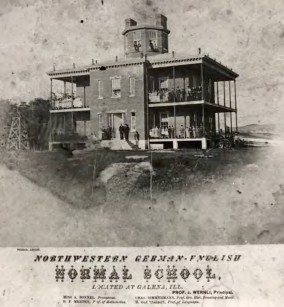
Figure 14. Marine Hospital after it became
Northwestern German-English Normal School
Alfred W. Mueller Collection, Galena State Historic Sites Office.
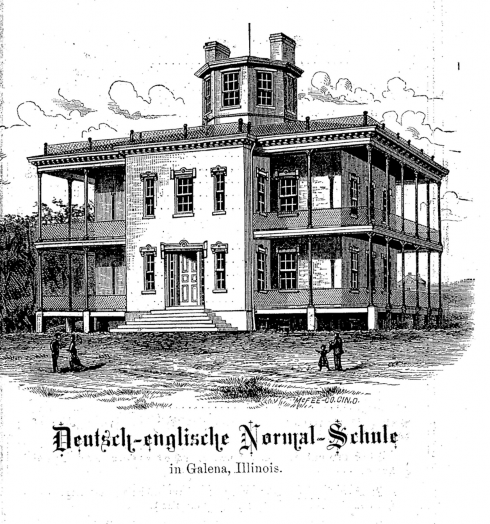
Figure 15. German-English Normal School.
Note the small farmhouse in the background.
Marine Hospital File - Galena-Jo Daviess County History Museum.
The first students came largely from the Galena area, but the school was soon advertising in Dubuque and beyond, in both English and German, with good results (Figure 15). An ad also appeared announcing that D.W. Held had a supply of very fine photographs of the school in a neat frame for only $2.00 each (Evening Gazette, 21 June 1870). The following year, as planned, the school was taken over by the Northwestern German Conference of the M. E. Church.
A pleasant description of the premises was offered by a reporter for the Gazette (9 November 1868). He described large and spacious rooms that were well lit and well equipped. He even noticed that some rooms were fitted with Harswood's patent combination desks with moveable seats.
The first graduates from the Normal Department were awarded their degrees in 1871; normal schools had two-year programs for those pursuing teaching (Figure 16). All but one of the graduates were from Galena (Catalogue of the Northwestern German-English Normal School, 1875, Marine Hospital folder, State Historic Sites Office). But there was also an Academic Department for those hoping to go on to a four-year college, and also a Preparatory Department for those too young or not ready for the higher departments.
Courses were taught in both English and German. As the years passed, English was used more than German (Figure 17).
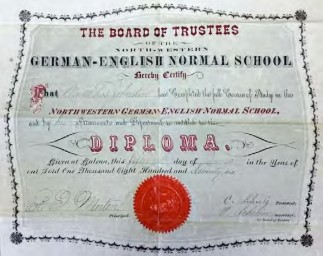
Figure 16. Early Diploma from
North-Western German-English Normal School
- 1876. Terry Miller Facebook image.
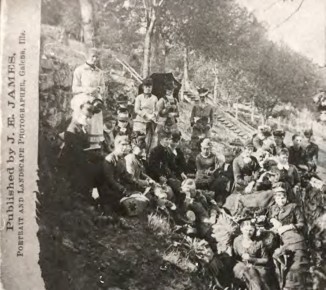
Figure 17. Students from the German-English School
having picnic at base of stairs leading up the hill to the school.
Alfred W. Mueller Collection - Galena State Historic Sites Office.
There was no on-campus housing, such as a boarding hall, so students without family nearby had to board with someone in town. This meant everyone did a lot of walking. To improve the situation, and to shorten the walk a little, school volunteers began to improve Park Avenue (then second street) from its terminus at the Henry Corwith home (now the Belvedere Mansion) to the foot of the stairs leading up to the school. But not everyone was pleased: "We learn that some of the people of that neighborhood called on some members of the City Council yesterday and objected to the improvement, though for what reason we cannot understand" (clipping dated 10 October 1873, Marine Hospital folder, State Historic Sites Office). The mayor and majority of the council, however, authorized the work to proceed (Figure 18).
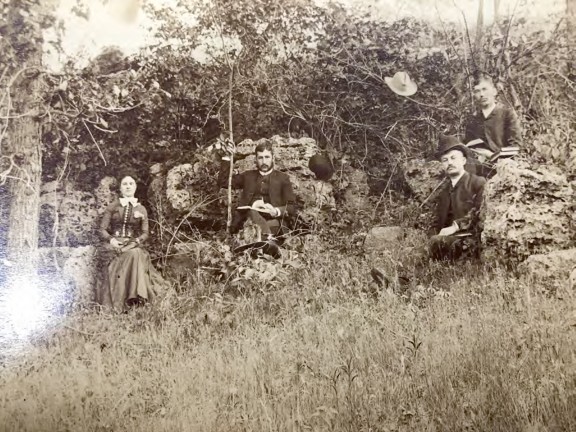
Figure 18. German-English Normal School-
students studying on grounds - circa 1885
- Alfred W. Mueller Collection - Galena State Historic Sites Office.
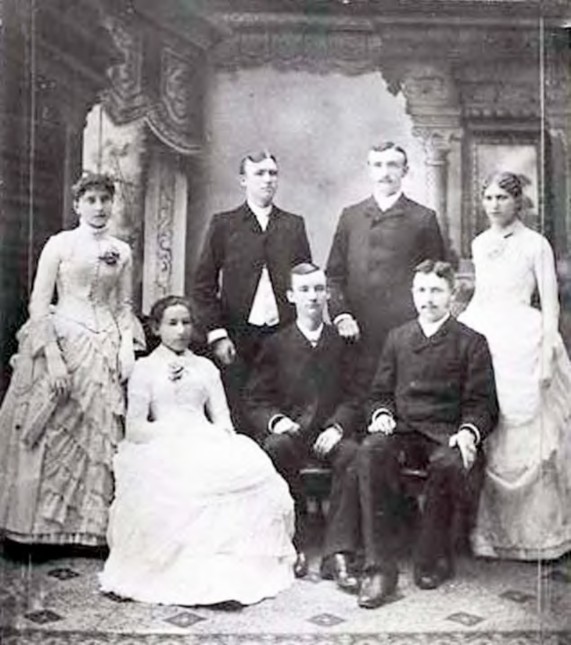
Figure 19. College Faculty German-English College for 1889-1890
Rev. Fr. Schaub, A. M., President, Mathematics and Commercial Work.
Rev. F. E. Hirsch, A. B. German and Ancient Languages.
Miss Carrie L. Schulz, Elementary German and Second Year's Sciences.
Rev. E. E. Schuette, Theology.
Prof. Geo. M. Hewey, B. L., English Language and Normal Work.
Miss Etta M. Berryman, Preparatory Branches.
Miss Ada Bachelor, Instrumental Music.
Galena Daily Gazette, 9 August 1889 - Courtesy of Tim Doser.
But the problem of ease of access remained. The Gazette reported in December of 1882 that a new sidewalk had been built from the home of Madison Y. Johnson (who had purchased the home of Henry Corwith when the latter moved to Chicago) to the German- English school (1 December 1882). But the trustees, noting that they had been in operation for 15 years, suggested that it would be difficult for them to remain in Galena without assistance from the city. Another difficulty was the access road, which during times of high water was impassable. A new one was needed but the city seemed unwilling to commit any real resources to the problem (Figure 19).
Demand for a four-year degree led the school to incorporate as a college in 1881, thus permitting the issuance of four-year degrees (Figure 20). The name changed to the German-English College (Catalogues of the German-English College for the years 1889-1890 and 1890-1891, Marine Hospital folder, State Historic Sites Office). The catalogs for the later years carried large amounts of advertising from area businesses, and many in Galena thought all was well, especially as tuition remained low (Figure 21).
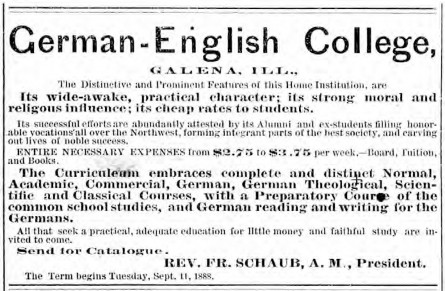
Figure 20. Advertisement for catalog of the German-English College for 1888.
Galena Daily Gazette, 24 August 1888.
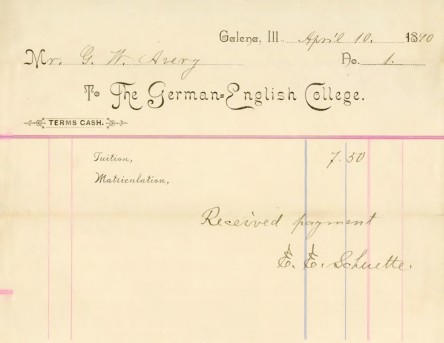
Figure 21. Receipt for German-English College
tuition for George Avery - 1890.
Terry Miller Facebook image.
But suddenly the ads for the 1890-1891 catalog were mostly from Charles City, Iowa. The Board of Trustees had determined that it was time to move. Increasing enrollments and a building too small--and difficult to access--were contributing factors. Some of the trustees felt that the old hospital had been remodeled for a purpose that it was never--and never could be--well adapted to (Catalog for 1890-91, pp. 5-6).
High water from the Galena river remained a threat to ease of access. And finances had been particularly difficult, with funds coming from tuition and donations from the Conference. It was felt that an addition to their building was needed, but there was no funding available. They also felt the need to be closer to the residential part of town, for the ascent up the hill to the school placed "too severe a strain upon many students, especially ladies" (Catalog for 1890-91, p. 6).
Over time, demand for such a school was coming increasingly from Iowa, and a more centralized location was also thought advantageous. The Trustees had come to the conclusion "that the location of the College at Galena was never a happy one." They voted to solicit bids from Iowa towns for new facilities. When Charles City, Iowa made an offer of $30,000 cash, a campus, and free use of city water for ten years, a majority of the trustees jumped at the offer. The new campus would open for the Fall, 1891 semester ((Catalog for 1890-91, pp. 5-6). The old Marine Hospital was once again in limbo.